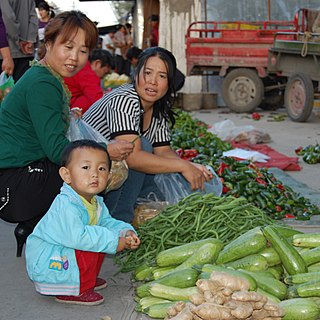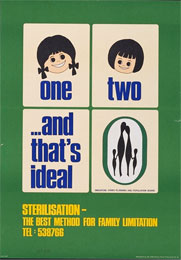
China's one-child policy was part of a birth planning program designed to control the size of its population. Distinct from the family planning policies of most other countries, it set a limit on the number of children parents could have, the world's most extreme example of population planning. It was introduced in 1979, modified in the mid 1980s to allow rural parents a second child if the first was a daughter, and then lasted three more decades before being eliminated at the end of 2015. The policy also allowed exceptions for some other groups, including ethnic minorities. The term one-child policy is thus a misnomer, because for nearly 30 of the 36 years that it existed (1979–2015) about half of all parents in China were allowed to have a second child.

Human population planning is the practice of intentionally controlling the rate of growth of a human population. Historically, human population planning has been implemented with the goal of increasing the rate of human population growth. However, in the period from the 1950s to the 1980s, concerns about global population growth and its effects on poverty, environmental degradation and political stability led to efforts to reduce human population growth rates. More recently, some countries, such as China, Iran, and Spain, have begun efforts to increase their birth rates once again.
Child benefit is a social security payment which is distributed to the parents or guardians of children, teenagers and in some cases, young adults. A number of different countries operate different versions of the program. In the majority of countries, child benefit is means-tested and the amount of child benefit paid is usually dependent on the number of children one has.

The birth rate is the total number of live births per 1,000 in a population in a year or period. The rate of births in a population is calculated in several ways: live births from a universal registration system for births, deaths, and marriages; population counts from a census, and estimation through specialized demographic techniques. The birth rate are used to calculate population growth.

The total fertility rate (TFR), sometimes also called the fertility rate, absolute/potential natality, period total fertility rate (PTFR), or total period fertility rate (TPFR) of a population is the average number of children that would be born to a woman over her lifetime if:
- She was to experience the exact current age-specific fertility rates (ASFRs) through her lifetime, and
- She was to survive from birth to the end of her reproductive life.

Sub-replacement fertility is a total fertility rate (TFR) that leads to each new generation being less populous than the older, previous one in a given area. In developed countries sub-replacement fertility is any rate below approximately 2.1 children born per woman, but the threshold can be as high as 3.4 in some developing countries because of higher mortality rates. Taken globally, the total fertility rate at replacement was 2.33 children per woman in 2003. This can be "translated" as 2 children per woman to replace the parents, plus a "third of a child" to make up for the higher probability of boys born and mortality prior to the end of their fertile life.
Compulsory sterilization, also known as forced or coerced sterilization, programs are government policies which force people to undergo surgical or other sterilization. The reasons governments implement sterilization programs vary in purpose and intent. In the first half of the 20th century, several such programs were instituted in countries around the world, usually as part of eugenics programs intended to prevent the reproduction of members of the population considered to be carriers of defective genetic traits.
Iran had a comprehensive and effective program of family planning since the beginning of the 1990s. While Iran's population grew at a rate of more than 3% per year between 1956 and 1986, the growth rate began to decline in the late 1980s and early 1990s after the government initiated a major population control program. By 2007 the growth rate had declined to 0.7 percent per year, with a birth rate of 17 per 1,000 persons and a death rate of 6 per 1,000. Reports by the UN show birth control policies in Iran to be effective with the country topping the list of greatest fertility decreases. UN's Population Division of the Department of Economic and Social Affairs says that between 1975 and 1980, the total fertility number was 6.5. The projected level for Iran's 2005 to 2010 birth rate is fewer than two.

Katō Shidzue was a 20th-century Japanese feminist and one of the first women elected to the Diet of Japan, best known as a pioneer in the birth control movement.

New Pedestrianism (NP) is a more pedestrian and ecology-oriented variation of New Urbanism in urban planning theory, founded in 1999 by Michael E. Arth, an American artist, urban/home/landscape designer, futurist, and author. NP addresses the problems associated with New Urbanism and is an attempt to solve various social, health, energy, economic, aesthetic, and environmental problems, with special focus on reducing the role of the automobile.A neighborhood or new town utilizing NP is called a Pedestrian Village. Pedestrian Villages can range from being nearly car-free to having automobile access behind nearly every house and business, but pedestrian lanes are always in front.
A two-child policy is a government-imposed limit of two children allowed per family or the payment of government subsidies only to the first two children. It has previously been used in Vietnam. In British Hong Kong in the 1970s, citizens were also highly encouraged to have two children as a limit, and it was used as part of the region's family planning strategies. Since 2016, it has been implemented in China, replacing the country's previous one-child policy.

Family planning in India is based on efforts largely sponsored by the Indian government. From 1965–2009, contraceptive usage has more than tripled and the fertility rate has more than halved, but the national fertility rate remains high, causing concern for long-term population growth. India adds up to 1,000,000 people to its population every 20 days. Extensive family planning has become a priority in an effort to curb the projected population of two billion by the end of the twenty-first century.
Chad is a source and destination country for children subjected to trafficking in persons, specifically conditions of forced labor and forced prostitution. The country's trafficking problem is primarily internal and frequently involves parents entrusting children to relatives or intermediaries in return for promises of education, apprenticeship, goods, or money; selling or bartering children into involuntary domestic servitude or herding is used as a means of survival by families seeking to reduce the number of mouths to feed. Child trafficking victims are primarily subjected to forced labor as herders, domestic servants, agricultural laborers, or beggars. Child cattle herders follow traditional routes for grazing cattle and at times cross ill-defined international borders into Cameroon, the Central African Republic (CAR), and Nigeria. Underage Chadian girls travel to larger towns in search of work, where some are subsequently subjected to prostitution. Some girls are compelled to marry against their will, only to be forced by their husbands into involuntary domestic servitude or agricultural labor. In past reporting periods, traffickers transported children from Cameroon and the CAR to Chad's oil producing regions for commercial sexual exploitation; it is unknown whether this practice persisted in 2009.

Population planning in Singapore spans two distinct phases: first to slow and reverse the boom in births that started after World War II; and second, from the 1980s onwards, to encourage parents to have more children because birth numbers had fallen below replacement levels.
On June 2, 2012, Feng Jianmei was forced to have an abortion in Zhenping County, Shaanxi, China, when she was seven months pregnant with her second child. Local officials had demanded that Feng and her husband pay a 40,000 yuan fine for violating the nation's one-child policy. When they were unable to do so, authorities arrested Feng, made her sign an agreement to have an abortion, and held her down while injecting her with an abortifacient. Feng was reportedly traumatized by the incident and in poor health afterwards.












